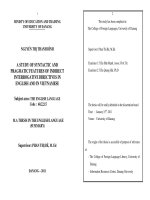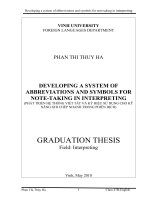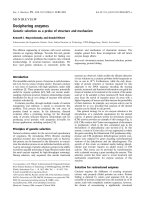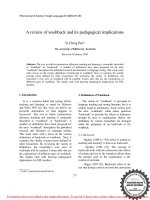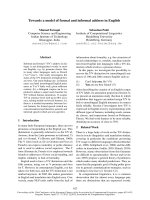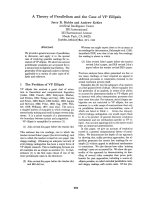ONFLICT MANAGEMENT STYLES: A PREDICTOR OF LIKABLITY AND PERCEIVED EFFECTIVENESS AMONG SUBORDINATES
Bạn đang xem bản rút gọn của tài liệu. Xem và tải ngay bản đầy đủ của tài liệu tại đây (572.98 KB, 73 trang )
CONFLICT MANAGEMENT STYLES: A PREDICTOR OF LIKABLITY
AND PERCEIVED EFFECTIVENESS AMONG SUBORDINATES
Rachel D. Copley
Submitted to the faculty of the University Graduate School
in partial fulfillment of the requirements
for the degree
Master of Arts
in the Department of Communication Studies,
Indiana University
June 2008
ii
Accepted by the Faculty of Indiana University, in partial
fulfillment of the requirements for the degree of Master of Arts.
Kim White-Mills, Ph.D., Chair
Catherine Dobris, Ph.D.
Master’s Thesis
Committee
Ronald Sandwina, Ph.D.
iii
DEDICATION
To my friends and colleagues in the Communication Graduate Program, from
whom I have learned so much, received such priceless encouragement and advice, and
without whom I would have missed so much during my time at IUPUI.
To the faculty who taught the academic material in class and the application
thereof through their commitment and dedication to their students.
To Dr. Catherine Dobris who has opened my eyes to new and fascinating ways of
viewing the world, and who remains my inspiration and the person I aspire to become.
To George, my best friend. Thank you for believing in me, even when I didn’t
believe in myself. You remain an important and valuable part of my life.
iv
ACKNOWLEDGMENTS
I would like to thank Dr. Kim White-Mills, my thesis advisor, for her friendship
and encouragement throughout this process. A special thanks to Dr. Ronald Sandwina
and Dr. Catherine Dobris for agreeing to be a part of my committee and for their
assistance and encouragement along the way. I would also like to acknowledge each
professor I have had in each class I have taken during my time at IUPUI. I gained great
value from each instructor and class assignment, and each experience has contributed to
the knowledge I now possess.
v
TABLE OF CONTENTS
Introduction 1
Purpose of Study 1
Likability 2
Effectiveness 2
Conflict 3
Conflict Management Styles 4
Literature Review 6
Description of Conflict Management Styles 6
Influence of Gender 11
Overview of Leadership Styles 15
Limitations of Past Research on Leadership 18
Men and Women in Leadership 19
Societal Prescriptions 21
Social Role Theory 24
Role Congruency 26
Conclusion 28
Research Questions 30
Methodology 31
Participants 31
Instruments 31
Data Analysis 33
Results 35
Response Level 35
Research Question One 35
Research Question Two 36
Research Question Three 37
Research Question Four 37
Discussion 38
Research Question One 38
Research Question Two 43
Research Question Three 45
Research Question Four 46
Conclusion 48
Appendix A 50
Appendix B 51
Appendix C 51
Appendix D 53
Appendix E 54
References 55
Curriculum Vitae
1
INTRODUCTION
As greater numbers of women throughout the past few decades have assumed
managerial roles in organizations, the question of whether gender differences exist in the
ability to manage effectively has become an important concern. According to Korabik,
Baril, and Watson (1993), conflict management skills are a fundamental aspect of
leadership effectiveness and “perceptions of how females handle crisis and conflict often
are cited as blocks to the female manager’s ascent to the executive suite” (Shockley-
Zalabak, 1981, p. 289). Additionally, the importance of likability of supervisors by their
subordinates has become of greater importance in the past few years as researchers have
discovered that more people leave their job because they do not like their supervisor than
for any other reason (Agrusa, Spears, Agrusa, & Tanner, 2006; Joyce, 2006). In addition
to the costs accumulated from hiring and training new employees, customer satisfaction
is directly related to employee loyalty. Employee dissatisfaction with supervisors,
therefore, may in turn jeopardize the objectives of the organization (Abbasi & Hollman,
2000).
Purpose of Study
The purpose of this study was to examine gender differences in supervisor’s
conflict management styles and to determine how they relate to both effectiveness and
likability among their subordinates. The term gender is used because of the assumption
that any such differences likely result from culture or experience, rather than biology. It
should be recognized, however, that gender was not directly measured, but was rather
operationalized in terms of the biological sex of the subjects researched. Specifically,
research was conducted to reveal a) what differences exist between conflict management
2
styles chosen by women and men leaders, b) if a relationship exists between conflict
management styles and likeability among subordinates, c) what influence conflict
management styles have upon perceived effectiveness among subordinates, and d) what
correlation exists between likability and perceived effectiveness.
Likability
A great deal of research has been dedicated to the topic of likability. While
aspects of what makes a person likeable have been presented, studies have varied in their
measurement of the actual construct of likeability (Reysen, 2005). Likability has been
labeled both a persuasion tactic and a method of self presentation (Cialdini, 1993;
Kemick, Neuberg, & Cialdini, 2002). Aspects that appear to increase likability include
physical attractiveness, similarity to self, compliments and association (Cialdini, 1993).
Physically attractive individuals have been rated as more talented, kind, honest and
intelligent (see Eagly, Ashmore, Makhijani, & Longo, 1991). Similarity to ourselves has
been shown to increase likability (Byrne, 1971; Carli, Ganley, & Pierce-Otay, 1991;
Hogg, Cooper-Shaw, & Holzworth, 1993). Additionally, compliments or praise increase
likability (Berscheid & Walster, 1978; Byrne & Rhamey, 1965; Drachman, deCarufel, &
Insko, 1978).
Effectiveness
According to Bass and Stogdill (1990), competence is “the capability that a
person brings to a situation” (p. 97). Within the context of organizations, competence, or
more specifically, effectiveness has been defined as a combination of quality and quantity
of performance within the unit or section for which the manager holds responsibility
(Luthans et al., 1985). More importantly, it has been noted that the perception, more so
3
than the actuality, of managerial competence determines the interpersonal dynamic and
effectiveness of an organizational team (O’Driscoll, Humphries, & Larsenwhich, 1991).
Subordinate perceptions of managerial competence is defined by Mott (1972), as
encompassing technical knowledge, human relations skills, administrative expertise, as
well as issues such as mutual trust and confidence. Therefore, although a manager may
believe him or herself to be an effective leader, if this opinion is not shared by his or her
subordinates, the leadership efforts will result in failure (Bass, 1960). As Downton (1973,
p. 95) explains:
The greater a leader’s competence as perceived by the follower, the
greater the probability that the follower will transact goods with him…We
should expect the leader’s information, skills, and personal temperament
to be important factors influencing the formation and maintenance of
follower commitments. . . Competence to cope with the instrumental tasks
of the group is an important criterion in selecting leaders, for it is through
the leader’s successful performance of his instrumental functions that
rewards are accumulated by individual followers.
Conflict
If an individual is perceived to manage conflict in an appropriate and effective
manner within an organizational setting, that individual is also perceived to be more
competent in general (Gross & Guerrero, 2000). Researchers in recent years have
evaluated the basic assumptions underlying organizational conflict, questioning much of
the existing body of conflict research (Jameson, 1999). The old view held that conflict is
filled with simple procedures and structures. The old, non-contextual view of conflict
meant that researchers could take an optimistic view of the generalizability of research
findings (Lewicki et al., 1992). In recent years, however, literature on marketing,
management, organizational behavior and social psychology has been filled with studies
4
regarding conflict’s dimensionality and intricacy (Song, Dyer, & Thieme, 2006). Many
scholars believe that the failure to incorporate these factors into conflict research has had
a negative impact on the value of research findings and has slowed theoretical
development (Jameson, 1999; Song, Dyer, & Thieme, 2006). For example, Jehn and
Chatman (2000) argue “the most common conceptualization of conflict may be
incomplete and hinder the usefulness of the research” (p. 56).
Wilmont and Hocker (2001, p. 41) state that conflict is “an expressed struggle
between at least two interdependent parties who perceive incompatible goals, scarce
resources and interference from others in achieving their goals” and conflict management
styles refer to “patterned responses, or clusters of behavior, that people use in conflict”
through diverse communication tactics (Wilmot & Hocker, 2001, p. 130). At the
individual level, conflict begins “when one party perceives that the other has negatively
affected, or is about to negatively affect, something that he or she cares about" (Thomas,
1992, p. 653). At the cultural level, conflicts occur between members of different
cultures, and members of the same culture who feel that cultural rules or norms are being
violated (Wilmot & Hocker, 2001, p. 66). Although the definitions of conflict are
different from one researcher to another and are dependant on situational variables,
conflict can be generally defined as the interaction of interdependent people who perceive
opposition of goals, aims and values, and who see the other party as potentially
interfering with the realization of these goals (Putnam & Poole, 1987).
Conflict Management Styles
Researchers have suggested that an individual’s conflict style is a behavioral
orientation of how to approach and handle conflict, with individuals choosing a pattern of
5
principles to guide them through the conflict process. These patterns evolve into actions
and reactions that become known as their “style” (Ruble & Thomas, 1976; Thomas,
1976; Thomas & Kilmann, 1978). According to Thomas (1976) and Folger et al., (1997),
conflict management style is a “general and consistent orientation toward the other party
and the conflict issues, manifest in observable behaviors that form a pattern and share
common characteristics over time” (Kuhn & Poole, 2000, p. 560).
6
LITERATURE REVIEW
This chapter will provide a review of literature related to conflict and conflict
management styles, and how these concepts relate to gender and leadership effectiveness
of supervisors within organizations. In this chapter, the various conflict management
styles referenced in this study will be reviewed, and an overview will be given of how
these definitions relate to past and current scholarship. Second, what scholarly literature
reveals regarding the role gender occupies in conflict management will be discussed.
Third, an overview of the studies which have been performed on leadership styles will be
presented. Fourth, the relevant research that has been conducted on the leadership styles
of women and men in organizations will be discussed, and the limitations that exist
within this research will be examined. Finally, the theoretical base for this study will be
established by reviewing the tenets of social role theory. Additionally, how social
expectations shape women’s behavior and interaction in an organizational setting will be
examined, as well as how perceptions of women leaders are shaped by their subordinates.
Description of Conflict Management Styles
Conflict management style has been and continues to be measured by a variety of
classifications. Follett (1940) first conceptualized the first five-style classification of
behavioral conflict-handling strategies in the 1920’s. Follett reported findings of methods
individuals typically use when dealing with conflict: domination, compromise,
integration, avoidance and suppression. Another one of the first conceptual schemes for
classifying conflict revolved around a simple dichotomy involving either cooperation or
competition (Deutsch, 1949). Deutsch defined conflict as incompatible interaction
between two individuals, where one is interfering, obstructing or in other ways making
7
the behavior of another less effective. He argued that the dynamics and outcomes of
conflict depend upon whether the conflict is handled cooperatively or competitively.
However, doubts were raised over the ability of Deutsch’s (1949) dichotomy to
reflect the complexity of an individual’s perceptions of conflict behavior (Ruble &
Thomas, 1976; Smith, 1987) and a new two-dimensional grid for classifying the styles
was developed by Blake and Mouton (1964). Based on Follett’s (1940) classifications,
Blake and Mouton (1964) grouped the various styles for handling interpersonal conflict
into five types: forcing, withdrawing, smoothing, compromising and problem solving.
Blake and Mouton’s (1964) work proposes that conflict is managed in different ways
depending on whether the individuals, specifically managers, involved have high or low
concern for production and high or low concern for people. By juxtaposing the two
dimensions, then, they generated five styles: problem solving resulting from high concern
for productivity and people, forcing showing high concern for productivity and low
concern for people, compromising based on moderate concern for productivity and
people, smoothing depending on low concern for productivity and high concern for
people, and withdrawing representing low concern for productivity and low concern for
people.
Thomas and Kilmann (1974) also developed a model for handling conflict that
utilizes five styles: competing, collaborating, avoiding, accommodating and
compromising. The competing style is high in concern for self, which is characterized by
a drive to maximize individual gain, even at the expense of others. This style is in
contrast to the collaborating style, which constructs solutions to conflict to meet the needs
of all parties involved. The avoiding style is low in concern for self and disengages from
8
conflict. The accommodating style sacrifices self-interests to satisfy the needs of others.
Finally, compromising theoretically straddles the midpoint between cooperativeness and
assertiveness, and involves making concessions to arrive at a resolution of conflict.
On the basis of a factor analysis of the items of their Organizational
Communication Conflict Instrument, Putnam and Wilson’s (1982) three-conflict
management style model divides conflict management strategies into three factors: non-
confrontation (obliging), solution-oriented (integrating) and control (dominating).
Putnam and Wilson (1982) state that non-confrontation, or obliging, strategies manage
conflict indirectly, by either simply avoiding disagreements or by minimizing
controversial issues. Solution-oriented, or integrating, strategies manage conflict both by
searching for creative, integrative solutions and by making compromises. Control, or
dominating, strategies manage conflict by arguing persistently for their positions and
using nonverbal messages to emphasize demands.
Pruitt (1983) provided empirical evidence from laboratory studies that there are
four styles of handling conflict: yielding, problem solving, inaction and contending.
Based partially on Blake and Mouton’s (1964) two level component, these styles were
based on a two dimensional model consisting of concern for self (high or low) and
concern for others (high or low).
While numerous researchers proposed revisions of the preceding frameworks,
Rahim and Bonoma’s (1979) conceptualization has been one of the most popular, with
empirical evidence (e.g., Rahim & Magner, 1995; van de Vilert & Kabanoff, 1990)
suggesting it to be most valid. Rahim and Bonoma (1979) differentiated the styles of
resolving interpersonal conflict on two basic dimensions: concern for self and concern for
9
others. The first dimension explains the degree (high or low) to which a person attempts
to satisfy their own concerns, while the second dimension explains the degree to which
an individual tries to satisfy the needs or concerns of others. The combination of these
two dimensions results in five specific styles of conflict management, known as
integrating, obliging, dominating, avoiding and compromising.
Integrating is characterized by both high concern for self and for others. This
involves openness, exchange of information, and examination of differences to reach an
effective solution acceptable to both parties. It is associated with problem solving, which
may lead to creative solutions. This style has been found to be useful in utilizing the
skills and information of different individuals to generate solutions, and may be
appropriate for dealing with strategic issues relating to objectives, policies and long-range
planning (Afzalur, Garrett, & Buntzman, 1992).
An obliging style involves low concern for self and high concern for others. This
style is associated with attempting diminish differences and emphasize commonalities for
the purpose of satisfying the needs of the other party. This style has been found to be
used by an individual believing that he or she may be wrong and that the issue in question
is much more important to the other person involved. It can be used as a strategy when an
individual is willing to make a concession with the hope of getting something in return
(Afzalur, Garrett, & Buntzman, 1992).
A dominating style is characterized by high concern for self and low concern for
others. This style has been identified with a win-lose perspective or with forcing behavior
by one individual over another as a means to win a position or resolve a conflict situation.
An individual using a dominating style typically uses whatever measures necessary to
10
win the objective, and as a result, ignores or minimizes the needs and expectations of the
other party. This style is often used when the issues involved in a conflict seem relatively
unimportant or when a quick decision is required. A dominating may style may also be
used by upper management for implementing strategies and policies, or when unpopular
courses of action must be implemented (Afzalur, Garrett, & Buntzman, 1992).
An avoiding style is associated with both low concern for self and others. This
style is usually accompanied by withdrawal, as an individual using this style fails to
satisfy both his or her concerns as well as the concerns of the other party. This style is
often used when the potential ramifications of confronting the other party seem to
outweigh the benefits of resolving the conflict. This style has often been found to be used
when individuals deal with perceived tactical or minor issues (Afzalur, Garrett, &
Buntzman, 1992).
Compromising is associated with an intermediate level of concern for both self
and others. This style typically involves “give and take” where both parties involved
relinquish some aspect in order to arrive at a mutually-acceptable decision. This style is
often used when the goals of the conflicting parties are mutually exclusive or when both
parties, who are equally powerful, such as a labor union and management, have reached
an impasse. This style is used when dealing with particular strategic issues (Afzalur,
Garrett, & Buntzman, 1992).
Some researchers have suggested that successful conflict management involves
using specific styles to resolve conflict situations; for example, that the integrative or
problem-solving style is most appropriate for managing all conflict (Blake & Mouton,
1964; Likert & Likert, 1976). Other researchers have indicated that for conflicts to be
11
managed most effectively, one style is more appropriate than the other, based on the
situation (Rahim & Bonoma, 1979; Thomas, 1992). According to Gross and Guerrero
(2000), the effectiveness of individuals is perceived based on which conflict management
styles they choose to incorporate. They discovered that an integrative conflict
management style is generally perceived as the most appropriate (in terms of being both a
polite, prosocial strategy, and an adaptive, situationally appropriate strategy) and most
effective style. The dominating style tended to be perceived as inappropriate, and the
obliging style was generally perceived as neutral. The avoiding style was generally
perceived as both ineffective and inappropriate. Finally, compromising was perceived as
a relatively neutral style.
Influence of Gender
Taylor and Hardman (2004) posit that “gender must be seen as more than an
individual's sex; it must be seen, simultaneously, as: a characteristic of (some) languages;
sets of expectations for individuals’ behaviors, attitudes and feelings; sets of social
structures created and recreated through human interactions; complex webs of
relationships; ideology; interactive outcomes of perceptions and self-presentations, thus
always in progress and in relations” (p. 3). With increasing numbers of women moving
into decision making positions in organizations (Neubert & Palmer, 2004), coupled with
the obvious importance of conflict management skills in providing effective leadership,
there has been an increased focus on the gender differences in managing conflict.
Early research was often tainted by stereotypical assumptions about women in
both the research design and in the interpretation of the data. For example, results from
psychological studies, especially those prior to the 1980’s, suggested that men and
12
women tend to endorse conflict management strategies that complement gender role
expectations (Wachter, 1999). Additionally, older research examining individual
differences in conflict management style focused upon gender as an explanatory variable,
and suggested that the five conflict management styles are compatible with gender role
orientation (Bern & Lenney, 1976; Kagan, 1964; Maccoby, 1966). Bern and Lenney
(1976), for example, suggest that strongly sex-typed individuals are constrained to their
respective stereotypical behaviors, whereas androgynous individuals have greater
behavioral flexibility and can adopt both masculine and feminine conflict management
characteristics. Interestingly, research from this same time frame also suggested that
women are competitive based upon contextual variables (Bedell & Sistrunk, 1973; Rubin
& Brown, 1975). According some (Bern, 1974; Bern & Lenney, 1976; Spence &
Helmreich, 1978), differences in conflict management behavior of men and women are
determined by gender roles, which are considered to represent learned patterns of
masculine and feminine characteristics, and determine how individuals behave in certain
circumstances (Cook, 1985). For example, men are generally thought to develop
masculine characteristics, which include aggressiveness, independence, competitiveness
and assertiveness, while women are thought to develop feminine characteristics such as
emotionality, sensitivity and cooperativeness (Broverman, Vogel, Broverman, Clarkson,
& Rosenkrantz, 1972). Since an individual's progress in an organization often seems to
have been associated with the possession of masculine rather than feminine
characteristics (Brenner et al., 1989; Heilman, Block, Martell, & Simon, 1989; Powell &
Butterfield, 1979), it is possible that in order to progress in their careers women were
either forced to adopt a more masculine orientation, or naturally made their way to the
13
top by virtue thereof. Supporting this suggestion is research evidence which strongly
suggests that women managers made their way into their top positions because they
possessed more masculine characteristics than women in the general population
(Fagenson, 1990; Powell, 1988).
Supporting this hypothesis, additional previous findings (Korabik & Ayman,
1987) suggested congruence between gender and conflict management styles, and
suggest that women deliberately choose a cooperative orientation to conflict management
than do men (Rahim, 1983; Rubin & Brown, 1975). In efforts to resolve conflicts, women
self-report softer tactics as a first resort more so than do men, who report greater use of
more aggressive tactics, including pressure and contention (Carothers & Allen, 1999;
Gruber & White, 1988; Offerman & Schrier, 1985; Pruitt, 1998). For example, according
to Monroe, DiSalvo, Lewis, and Borzi (1991), male subordinates used relational leverage
(confrontation) more often with female supervisor and female subordinates used
avoidance more often with male supervisors.
Additionally, women in professional settings reported that they were more likely
to use affilitative (Baker, 1991; Lucas & Lovaglia, 1998) and indirect negotiation
strategies (Sagrestano, 1992). Additional researchers have indicated female supervisors
tend to use interpersonal, compromising, collaborative, accommodating, integrating,
cooperative, avoiding, pro-social communicative methods (Gibbs & Lach, 1994a, 1994b;
Lay, 1994; Sorenson & Hawkins, 1995; Korabik, Baril, & Watson, 1993; Conrad, 1991;
Monroe et al., 1991; Fink & Brunner, 1987). These findings are consistent with Eagly
and Johnson's (1996) argument that the strongest evidence for gender differences in
14
leadership style is the tendency for women to adopt a more participative and democratic
style and men a more autocratic or directive style.
Other researchers have questioned whether male and female managers differ at all
in their preferred conflict management style (Baxter & Shepard, 1978; Yelsma & Brown,
1985). Many of the studies that have demonstrated gender differences have employed
nonmanagerial samples (e.g., Chanin & Schneer, 1984; Kilmann & Thomas, 1977; Ruble
& Stander, 1990; Rosenthal & Hautaluoma, 1988) and gender differences are found more
frequently among such samples than among samples of managers (Powell, 1988). Also,
even when managers are used as subjects, the men and women are usually not equivalent
in age, education, or managerial experience. Gender differences in conflict management
style, if they exist at all, tend to disappear once these other factors are controlled
(Champion, 1979; Chusmir & Mills, 1988; Korabik & Ayman, 1987). Thus, men and
women managers who are similar to one another do not appear to differ in self-reports
about their preferred conflict management style (Renwick, 1975, 1977; Shockley-
Zalabak, 1981).
According to Burrell, Buzzanell, and McMillan, (1992), the equivocality of these
findings may be explained by the fact that women approach conflict in unique ways that
may not be apparent or surface in empirical investigations that quantify results and
predict outcomes, and that “equivocality may be associated with the research methods
used by investigators” (p. 121). Women’s conflict orientations tend to emerge when
ethnographic, sociolinguistic, rhetorical-critical and feminist methodologies are utilized
instead. Research using these more experiential methods have uncovered findings such as
women’s struggles to preserve intimacy and avoid isolation in communication (Gilligan,
15
1982; Maltz & Borker, 1982; Pearson, Turner, & Todd-Mancillas, 1991); organizational
dilemmas related to being paradoxically female and professional (Fairhurst, 1986; Moore,
1988; Wood & Conrad, 198) and suppression of authenticity by pervasive patriarchal
expressions of expected behaviors and speech (Gillian, 1982; Lewis, 1990).
Overview of Leadership Styles
Eagly and Johannesen-Schmidt (2003) define leadership style as relatively stable
patterns of behavior displayed by leaders. Studies on leadership have suggested that
leadership styles are generally either agentic or communal, with agentic described as “an
assertive, controlling, and confident tendency – for example, aggressive, ambitious,
dominant, forceful, independent, daring, self-confident, and competitive” and communal
described as “affectionate, helpful, kind, sympathetic, interpersonally sensitive, nurturant
and gentle” (Eagly & Johannesen-Schmidt, 2001, p. 783). Most commonly reported was
a distinction between two approaches to leadership: task-oriented style, defined as a
concern with accomplishing assigned tasks by organizing task-relevant activities, and
interpersonally oriented style, defined as a concern with maintaining interpersonal
relationships by tending to others’ morale and welfare. This distinction was introduced by
Bales (1950) and developed further by Hemphill & Coons (1957). In this research, task-
oriented style, labeled initiation of structure, included behavior such as encouraging
subordinates to follow rules and procedures, maintaining high standards for performance,
and making leader and subordinate roles explicit. Interpersonally oriented style, labeled
consideration, included behavior such as helping and doing favors for subordinates,
looking out for their welfare, explaining procedures, and being friendly and available.
16
Other studies distinguished between leaders who a) behave democratically and
allow subordinates to participate in decision making or b) behave autocratically and
discourage subordinates from participating in decision making. This dimension of
leadership, ordinarily termed democratic versus autocratic leadership or participative
versus directive leadership, followed from earlier experimental studies of leadership style
(e.g., Lewin & Lippitt, 1938) and was further developed by a number of researchers (e.g.,
Vroom & Yetton, 1973).
In the 1980’s and 1990’s, many researchers turned their attention to new types of
leadership styles by distinguishing between leaders who are transformational and those
who are transactional (Bass, 1998). This effort was initially inspired by Burns’s (1978)
argument that existing analyses of leadership style left out some of the most important
aspects of effective leadership. This new work emphasized that effective leaders inspire
their followers and nurture their ability to contribute to the organization. This approach
initially emerged in Burns’s (1978) delineation of a type of leadership that he labeled
transformational. According to Eagly and Johannesen-Schmidt (2003) these two types of
leadership – transformational and transactional – are both displayed by effective leaders.
In addition to transformational and transactional leadership, researchers have
distinguished a laissez-faire style that is marked by a general failure to take responsibility
for managing (Eagly & Johannesen-Schmidt, 2003).
As elaborated by Bass (1985, 1998), transformational leadership involves
establishing oneself as a role model by gaining the trust and confidence of followers.
Such leaders state future goals and develop plans to achieve them. Skeptical of the status
quo, they innovate, even when the organization that they lead is generally successful. By
17
mentoring and empowering their followers, transformational leaders encourage them to
develop their full potential and thereby to contribute more capably to their organization.
Many of these same qualities also were studied by researchers who labeled this future
oriented, empowering style as charismatic leadership (Conger & Kanungo, 1998). Burns
(1978) and other researchers (Avolio, 1999; Bass, 1998) contrasted transformational
leaders to transactional leaders, who appeal to subordinates’ self-interest by establishing
exchange relationships with them. This type of leadership involves managing in the more
conventional sense of clarifying subordinate responsibilities, rewarding them for meeting
objectives, and correcting them for failing to meet objectives. Researchers have
suggested that transformational leadership contributes to the success of organizations,
and is therefore a preferred leadership style to be followed (Eagly & Johannesen-
Schmidt, 2003).
The significance the of choice of conflict management style on leadership ability
is aptly described by Lehnen, Ayman, and Korabik (1995), who examined the conflict
management styles of female and male leaders. Results indicated that transformational
leadership was strongly associated with using an integrative conflict management style.
The relationship between transformational leadership and satisfaction was shown to be
mediated by the conflict management style used by the leader. Leaders who described
themselves as more transformational used integrative conflict management styles and had
followers with greater levels of satisfaction. However, in Lehnen et al.’s study, this
relationship was stronger for the female versus male managers in the sample, and self-
described male transformational leaders described themselves as using more of a
compromising style of conflict management.
18
Limitations of Past Research on Leadership
Because men have long held leadership roles and have defined the leadership
styles to which people have become accustomed (Eagly & Johannesen-Schmidt, 2001),
virtually all theories of effective management have been based on observations of male
managers (Powell, 1988). Researchers have long made judgments regarding what
effective management is, not recognizing that the majority of managers are male and are
therefore judged on their adherence to the male gender stereotype. Wilson (2003) asserts
that there remains a persistent stereotype that associates management with “being male”
(p. 64), and that whichever characteristics are considered important for managers, they
appear to be the ones generally identified more closely with men than with women. It is
not surprising, then, that masculinity remains prevalent in the ranks of management, and
that the perception remains that successful managerial characteristics are more likely to
be held by men than by women (Schein, 2001). This perception unfortunately discounts
that although managers tend to be masculine, better managers are not necessarily
masculine nor do better managers necessarily adhere to masculine-typed behaviors
(Wilson, 2003).
In addition to this dilemma, women and issues about their work have been
considered by many to be less important than that of men, and as such, less extensive and
in-depth research has been conducted on them (Wilson, 2003). If not ignored altogether
in organizational theory, women’s perspectives and ideas have often been absent, buried
or marginalized. When women and issues or concern to women are studied, the research
questions are too often framed through the eyes of men (Unger & Crawford, 1992). For
example, when gender is acknowledged in books, the “male as norm” syndrome appears,
19
as was the case in a textbook on communication in small group that featured an index
entry for “women in groups” (Bormann, 1990, p. 303). No entry exists for “men in
groups,” which suggests that women are not the norm and therefore deserve special
research. In a male-dominated workplace, the expectation is that women’s experiences
can be adequately understood through the filter of the dominant gender culture
(Sheppard, 1992).
There are obviously many more women in the workforce now and in higher
positions, which may have changed women’s communication and leadership for a host of
reasons. However, although women have made considerable gains in management roles,
the glass ceiling remains firmly in place, with women still clustered in staff jobs, rather
than in line management jobs that are more likely to lead to higher level positions
(Meyerson & Fletcher, 2000).
Although in recent years women have been the focus of discussions of the impact
of gender on leadership, there is little agreement about how women actually lead, and a
continuing debate of whether men and women behave differently in leadership roles.
Although there is general agreement that women face more barriers to becoming leaders
than do men, especially for leader roles that are male-dominated (Eagly & Karau, 2002),
there is much less agreement about the behavior of women and men once they attain such
roles.
Men and Women in Leadership
Powell and Graves (2003) suggest that the “sex of the individuals who hold leader
roles should be of little concern. What should matter is how individuals, male and female,
respond to the demands of the particular leader role that they occupy. However, the sex
20
of leaders does make an emphatic difference to others” (p. 151). Corroborating this
observation, the past few decades, management literature has been filled with the ongoing
debate of whether female and male managers use different leadership styles. The
advocates of difference in leadership styles between women and men include several
writers of trade books who have drawn on their personal experience in organizations as
well as informal surveys and interviews of managers (Eagly & Johannesen-Schmidt,
2001). These writers have claimed that the leadership styles of women and men are
different, mainly stating that women leaders are less hierarchical, more cooperative and
collaborative and more oriented to enhancing others’ self-worth (Book, 2000; Helgesen,
1990; Rosener, 1995). In contrast, social scientists have typically either claimed that
female and male organizational leaders do not differ or minimized the importance of
those differences that have been observed (Powell, 1990). Careful examination of
relevant research, however, has revealed more complex findings than acknowledged by
the advocates of difference or the advocates of similarity.
Early scholars expressed skepticism about women’s ability to assume managerial
roles and responsibilities, because managerial roles are often associated with masculine
rather than feminine characteristics (Brenner, Tomkiewicz, & Shein, 1989; Powell &
Butterfield, 1979). This skepticism was prevalent despite findings from research
examining leadership style in general, which suggests that males and females who
occupy equivalent managerial positions behave in much the same way (Eagly & Johnson,
1990; Korabik et al., 1993; Powell, 1988).
Through the early 1990’s, a growing body of research emerged positing that
gender differences in leadership styles do not exist, with several well-known management


